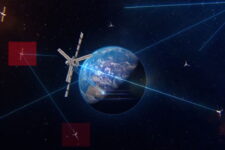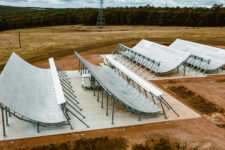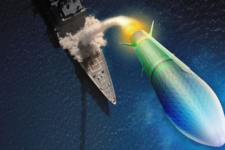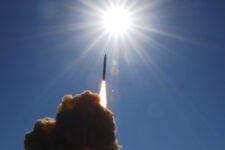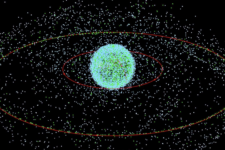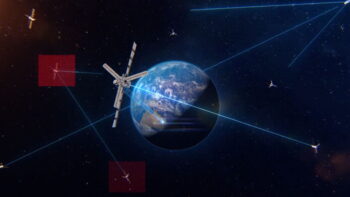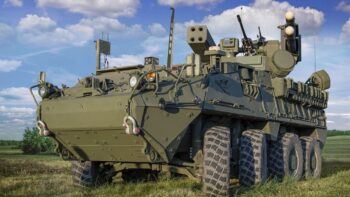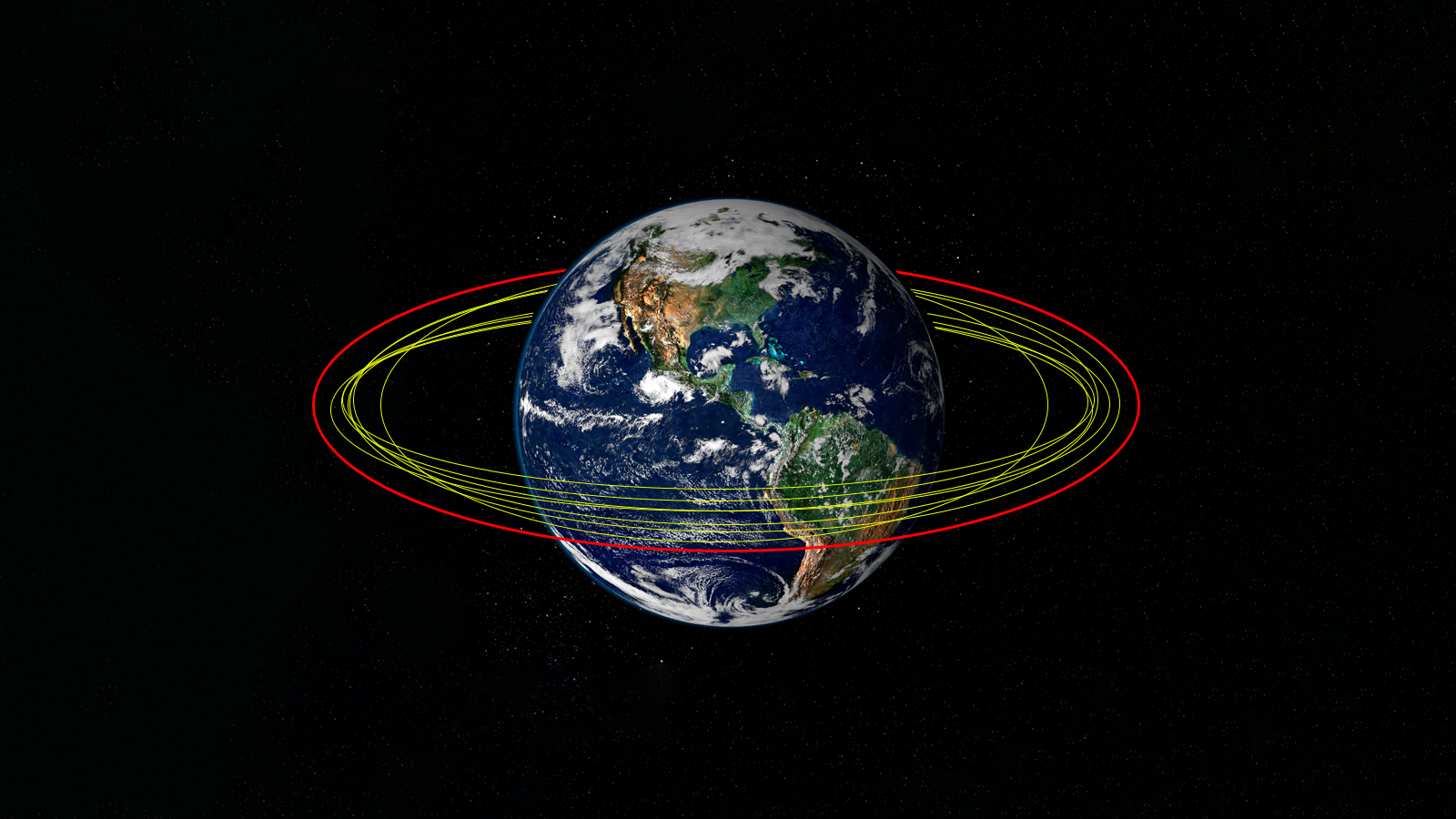
An artist’s concept visualizing orbits around the earth. (Breaking Defense graphic, original Earth graphic via NASA)
Updated: 05/22/2024 at 11:00 am EST to add SSC comment on the status of Victus Nox. WASHINGTON — A Russian satellite that the US suspects is a test-bed for future a nuclear anti-satellite weapon is operating in a rare orbit, one analysts tell Breaking Defense would be consistent with hosting a synthetic aperture radar (SAR) for observing the Earth — but possibly also for testing how best to deploy a future orbital nuclear weapon.
Cosmos 2553, according to independent experts, is in a circular orbit of about 2,000 kilometers at the farthest edge of the low Earth orbit (LEO) belt. The system, launched in February 2022, is operating in an area largely devoid of other systems — its only known companions are one dead Russian and 10 dead American commercial birds dating from the late 1990s.
That orbit, said Darren McKnight, senior technical fellow at LeoLabs, could have been chosen to both allow experimentation that wouldn’t affect other satellites, and because it makes it harder to keep tabs on. Further, he suggested, such an orbit might be safer for long-duration stationing of a satellite carrying a dangerous nuclear payload, in that it would be less like to be struck by debris or another satellite.
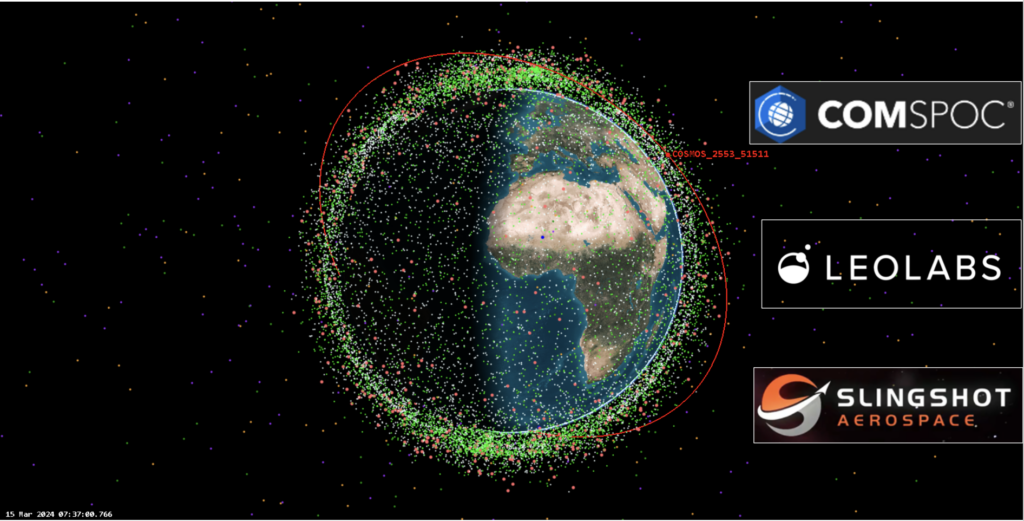
Image of Cosmos 2553’s orbital plan (in red) provided to Breaking Defense by COMSPOC.
To be clear, no US official has claimed, nor does any private sector sleuthing suggest, that Cosmos 2553 is carrying a nuclear weapon. But there has been a breadcrumb trail between the allegations from the US about Russia’s intent to put nuclear weapons in space, first made in February, and Cosmos 2553.
On May 3, Mallory Stewart, a senior State Department arms control official, made semi-cryptic remarks about an unnamed satellite in an “unusual” orbit as part of the alleged Russian program. She further noted that the satellite’s orbit was “not high enough of a radiation environment to allow accelerated testing of electronics, as Russia has described the purpose to be.”
Breaking Defense has since confirmed a May 16 Wall Street Journal report that said the Cosmos 2553 satellite is the system to which Stewart was referring. As of yet, however, no official has publicly named Cosmos 2553 as the satellite in question, despite the fact that the Pentagon has access to higher fidelity space monitoring data than open-source investigators — who have been busy studying the Russian system.
A number of independent experts have tagged Cosmos 2553 as, most likely, primarily designed as a SAR satellite to spy on ground targets. But several speculate the satellite could be undertaking experiments with a second payload — potentially one focused on testing how to protect subsystems of any future nuclear-armed ASAT from long-term exposure to ambient radiation and charged particles in the space environment, which could cause it to malfunction. At nearly 2,000 kilometers, Cosmos 2553 would be exposed to higher levels of radiation than lower down in LEO.
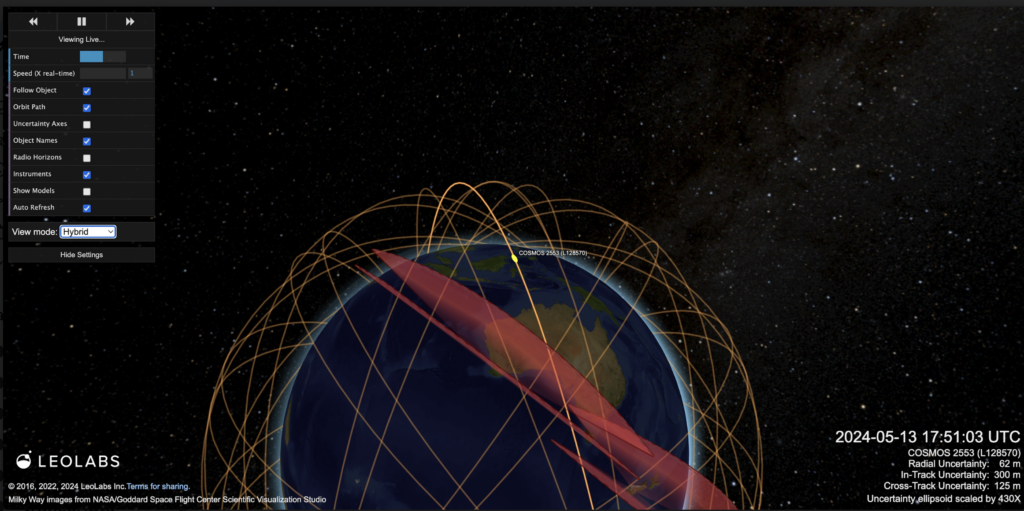
LeoLabs radar tracking visualization of Cosmos-2553.
“The big issue with nuclear weapons deployed in space is that they have to sit there a long time, unattended. So, I imagine that one possible explanation is gathering data on the long-term effects of sitting in orbit would be,” said Jeffrey Lewis, director of the East Asia Nonproliferation Program at the Middlebury Institute’s James Martin Center for Nonproliferation Studies in Monterrey, Calif.
Pavel Podvig, a senior researcher at the United Nations Institute for Disarmament Research in Geneva and a long-time watcher of Russia’s nuclear and space forces, agreed.
“My best guess right now is that there is an experiment that studies shielding of various electronic equipment. The US IC [Intelligence Community] seems to believe that this equipment has something to do with a nuclear weapon. But it’s nearly impossible to prove or disprove,” he told Breaking Defense.
Podvig was one of the first experts to identity Cosmos 2553, in a May 3 thread on the X platform (formerly Twitter) as a suspected SAR-sat likely at the center of Biden administration officials fears that Russia is developing an nuclear ASAT aimed at wiping out satellites in low Earth orbit (LEO).
In a May 13 essay in The Space Review, a fellow Russian satellite watcher, Bart Hendrickx, likewise did a deep dive on Cosmos 2553, also noting its likely SAR mission, as well as detailing possible linkages to recent studies on the effects of radiation underway within various Russian scientific institutes.
Eyes On LEO
As noted above, one oddity of Cosmos 2553’s orbit is the decision to place it in the upper reaches of LEO — well above most other satellites in that orbital region as noted by the American Enterprise Institute’s Todd Harrison in a May 16 post on X.
LEO is home to most of the world’s remote sensing satellites — but is also increasingly an orbital range of interest to the Defense Department, as it seeks to create a more resilient space force posture by using constellations of many small satellites for missions in the past done by only a few large satellites. In addition, SpaceX’s Starlink mega-constellation of thousands of high-speed, high-volume communications satellites, currently being used by Ukrainian forces in that country’s war with Russia, is stationed in LEO.
On the orbit of Cosmos-2553, press reports are implying that it is in a unique orbit. Here is a list of all objects with an apogee and perigee between 1900 and 2100 km. pic.twitter.com/o2FjdWO3Vw
— Todd Harrison (@ToddHarrisonDC) May 16, 2024
Further, both the United States and Russia have become increasingly interested in putting neighborhood watch satellites in LEO to, at a minimum, keep tabs on each other’s activities there. While the US space-monitoring birds so far have been, or are planned to be, launched into a lower orbit than Cosmos 2553, it is not so far away as to avoid their scrutiny — as several sources suggested to Breaking Defense.
The Space Force has been launching space domain awareness (SDA) birds to LEO as part of the service’s experimental campaign to speed up its launch cycle, both to respond rapidly to on-orbit threats and to allow rapid reconstitution of any space systems lost in a battle.
In June 2021, Space Systems Command’s Space Safari office launched its first small SDA satellite called Odyssey under its Tactically Responsive Launch-2 (TacRL-2) — a mission that started life under the Air Force in May 2019 under the name Rapid Space Launch Initiative (RSLI). (Robert Christy, a UK-based sat watcher, said in a blog post that Odyssey has deorbited, reentering the Earth’s atmosphere and burning up on Dec. 18, 2022.)
Space Safari’s second mission in the series was called Tactically Responsive Space-3 (TacRS-3), known more commonly by the code name of the satellite being launched, Victus Nox. In September 2022, Boeing’s Millennium Space Systems was chosen to build Victus Nox and Firefly Aerospace to provide the launch vehicle. The mission successfully met its 24-hour launch turnaround goal, lofting on Sept. 14, 2023.
Victus Nox was dubbed an “operational” experiment, designed to provide capability to SPACECOM. According to a Space Safari announcement on Feb. 19, the satellite “completed multiple maneuvers to conduct rendezvous and proximity operations and SDA.”
Further, the satellite currently remains in its orbit of around 435 kilometers in altitude, Jonathan McDowell, an astrophysicist at the Harvard–Smithsonian Center for Astrophysics’s Chandra X-ray Center, told Breaking Defense.
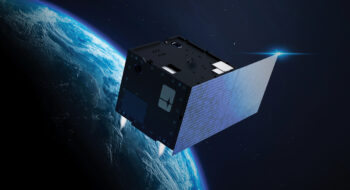
Victus Nox (Millennium Space Systems)
Space Systems Command on May 22 told Breaking Defense that Victus Nox is not “conducting a mission or broadcasting.” The satellite “has been placed in a final disposal orbit and passivated, following the standard practices for orbital debris mitigation.”
But it is clear that both Victus Nox, and Odyssey before it, had the opportunity while operational to assess Cosmos 2553.
The truth is it is inconceivable that any US LEO-based sensors would ignore any operational Russian satellite nearby. This not only includes Cosmos 2553, but also the satellite Russia launched on May 16 that US Ambassador Robert Wood told the UN Security Council is a likely counterspace weapon now shadowing a US government satellite.
As first reported by Space News on Tuesday, the new Russian bird, Cosmos 2576, has maneuvered into a co-orbital LEO plane at around 440 kilometers in altitude with the National Reconnaissance Office’s USA 314 (i.e. a spy sat).
Cosmos 2576 appears to be yet another of what Russia has dubbed “inspector” satellites for monitoring LEO, notes Secure World Foundation’s Victoria Samson in a thread on X. Space tracker Marco Langbroek in a May 20 blog post concurred, and provided a history of Cosmos 2576’s launch and orbital position. While the US has alleged the Russian inspector satellites are actually co-orbital ASATs, they have not suggested any of them are carrying nukes.
Finally, Space Safari already has plans for a next iteration next iteration of TacRS-3, dubbed Victus Haze. In April, Space Systems Command announced contracts under the new effort to Rocket Lab National Security and True Anomaly. The satellites to be developed by the two firms are to be optimized for close approaches to other satellites as well as SDA operations.
Lt. Gen. Philip Garrant, who heads Space Systems Command, told the Mitchell Institute today that the Victus Haze birds will be launched “sometime in 2025.”
Space Force boots RTX from MEO missile warning/tracking program
“This was done because the RTX Epoch 1 development effort was facing significant cost growth from the original agreement baseline, projecting slips to the launch schedule, and had unresolved design challenges,” a Space Systems Command spokesperson told Breaking Defense.
